The NASA Electronic Parts and Packaging (NEPP) '02 Workshop
The NASA Electronic Parts and Packaging (NEPP) '02 Workshop
The NASA Electronic Parts and Packaging (NEPP) '02 Workshop
Create successful ePaper yourself
Turn your PDF publications into a flip-book with our unique Google optimized e-Paper software.
Abstracts ________________________<br />
electrodes for photoelectrochemical energy conversion,<br />
photoelectrochemical processing of solids <strong>and</strong> photochemistry. Her<br />
work at JPL has concentrated on two primary areas of research:<br />
(a) development of chemical sensors for air quality monitoring, <strong>and</strong><br />
(b) investigations of metals <strong>and</strong> metal alloys for use in high<br />
temperature energy conversion devices. Dr. Ryan is the Principal<br />
Investigator on the <strong>NASA</strong> Life Sciences <strong>Electronic</strong> Nose<br />
Technology Development <strong>and</strong> Flight Experiment, now in its second<br />
phase, <strong>and</strong> the Principal Investigator at JPL on developing a<br />
Microarray Sensor in collaboration with the National Institute of<br />
St<strong>and</strong>ards <strong>and</strong> Technology. She is also the team leader for<br />
Advanced Power Sources, <strong>and</strong> co-inventor of a silicon carbide<br />
hydrocarbon sensor <strong>and</strong> of a colorimetric ozone sensor.<br />
Development <strong>and</strong> Application of High Temperature Sensors<br />
<strong>and</strong> <strong>Electronic</strong>s<br />
Gary Hunter<br />
<strong>NASA</strong> Glenn Research Center<br />
Clevel<strong>and</strong>, OH 44135<br />
Phone: 216-433-6459<br />
Fax: 216-433-8643<br />
Email: ghunter@grc.nasa.gov<br />
Abstract<br />
High temperature sensors <strong>and</strong> electronics are necessary for a<br />
number of aeronautical <strong>and</strong> space applications. Reliability <strong>and</strong><br />
durability of these devices is important for their use in high<br />
temperature, harsh environments. This talk will discuss the<br />
development of physical <strong>and</strong> chemical sensors as well as high<br />
temperature electronics. <strong>The</strong>se include thin film physical sensors,<br />
MicroElectroMechanical (MEMS) based chemical sensors, <strong>and</strong><br />
silicon carbide (SiC) based electronics. Each device type has its<br />
own technical challenges related to reliability in a given application.<br />
Examples include: 1. Durability of lead wire connections to the thin<br />
film for physical sensor measurements; 2. Sensor stability without<br />
loss of sensitivity for chemical species measurements; <strong>and</strong> 3.<br />
Device contacts with low, stable resistance for long-term operation<br />
of high temperature electronics. <strong>The</strong>se technical challenges as well<br />
as methods to improve the reliability <strong>and</strong> durability for each device<br />
type will be discussed.<br />
Speaker Biography<br />
Dr. Gary W. Hunter is the Technical Lead for the Chemical Species<br />
Gas Sensors Team at <strong>NASA</strong> Glenn Research Center. Since his<br />
arrival at <strong>NASA</strong> Glenn in 1990, he has been involved with the<br />
design, fabrication, <strong>and</strong> testing of sensors esp. chemical species<br />
gas sensors. He has worked closely with Case Western Reserve<br />
University (CWRU) for 10 years developing a range of sensor<br />
technologies using a number of different sensor materials <strong>and</strong><br />
sensing approaches. He has been active in the application of the<br />
resulting sensor technology both in <strong>NASA</strong> <strong>and</strong> industry. In 1995, he<br />
received an R&D 100 with CWRU <strong>and</strong> others for development of<br />
an Automated Hydrogen Leak Detection System, which has been<br />
used on the Ford automotive assembly line. Dr. Hunter has taught<br />
a short course on chemical sensing technology for three years at<br />
Sensors Expo, co-authored a book chapter, <strong>and</strong> served as an<br />
acting branch chief. He has been awarded the Silver Snoopy<br />
(2000), <strong>NASA</strong> Exceptional Achievement Medal (1998), <strong>NASA</strong><br />
Group Achievement Award (1998), <strong>and</strong> Space Flight Awareness<br />
Award (1997). Dr. Hunter is also a member of the Electrochemical<br />
Society Sensors Division Executive Committee <strong>and</strong> the AIAA<br />
Sensor Systems Technical Committee.<br />
27<br />
Gas Sensing Technologies for Space <strong>and</strong> Safety Applications<br />
Todd Hong<br />
<strong>NASA</strong> Johnson Space Center SR&QA / Technology Division<br />
Advanced Technology Group<br />
Houston, Texas<br />
Mail Code NX, 2101 <strong>NASA</strong> Road 1, Houston, TX 77058<br />
Phone: 281-244-1986,<br />
email: todd.c.hong1@jsc.nasa.gov<br />
Abstract<br />
<strong>The</strong>re is a rapidly growing need for highly sensitive gas detection<br />
devices that have low power consumption, quick response time<br />
<strong>and</strong> portability. Recent technological advancements in<br />
microtechnology, biotechnology, nanotechnology, <strong>and</strong> materials<br />
science have paved the way for tremendous improvements on<br />
proof-of-concept devices allowing for higher sensitivity, lower<br />
power consumption, smaller size, <strong>and</strong> higher reliability. Awareness,<br />
utilization <strong>and</strong> infusion of these advancements for integration into a<br />
single or multipurpose device are one of the objectives of the<br />
<strong>NASA</strong> JSC Safety, Reliability <strong>and</strong> Quality Assurance (SR&QA)<br />
Advanced Technology Group. Proper technology studies <strong>and</strong><br />
infusion of these devices into programs such as the International<br />
Space Station, Space Shuttle, <strong>and</strong> future generation vehicles<br />
ensures crew safety <strong>and</strong> mission success.<br />
<strong>The</strong> emphasis on gas sensing technologies will focus on the safety<br />
needs of the International Space Station <strong>and</strong> Space Shuttle<br />
Program.<br />
Speaker Biography<br />
Todd Hong is a systems engineer with Science Applications<br />
International Corporation, where he is the lead engineer for the<br />
<strong>NASA</strong> Safety, Reliability <strong>and</strong> Quality Assurance (SR&QA)<br />
Technology Division, Advanced Technology Group. He is<br />
responsible for the infusion <strong>and</strong> application of new <strong>and</strong> emerging<br />
advanced technologies into <strong>NASA</strong> programs <strong>and</strong> projects, where<br />
he has been actively involved with microtechnology, Micro Electro<br />
Mechanical Systems (MEMS), nanotechnology, biotechnology <strong>and</strong><br />
optics for safety <strong>and</strong> reliability. He is the principle investigator for<br />
the Orbiter Aft Compartment Gas Sampler System (OAFGSS)<br />
Replacement Using Microtechnology Project <strong>and</strong> a co-investigator<br />
for Microsystems-based Hydrazine Detection for International<br />
Space Station (ISS) <strong>and</strong> Extravehicular Activities (EVA)<br />
Applications, both with <strong>NASA</strong> Glenn Research Center. Mr. Hong<br />
has also participated in the Nanospace Conference, sponsored by<br />
Johnson Space Center in which he has served as Co-Chair for the<br />
MEMS Reliability session. He is a member of the Guidance,<br />
Navigation, <strong>and</strong> Control (GNC) Team for 3 rd Generation<br />
Technologies, Propulsion System Integration Group <strong>and</strong> served as<br />
project manager for Automated Gold Salt Hydrazine Monitor. He is<br />
the recipient of several awards including the <strong>NASA</strong> QASAR <strong>and</strong><br />
the <strong>NASA</strong> Group Achievement Awards. Todd earned his Bachelor<br />
of Science in Electrical Engineering from Texas Tech University.



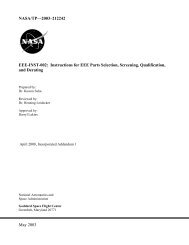

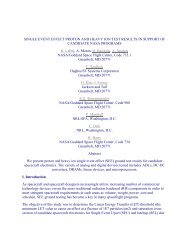
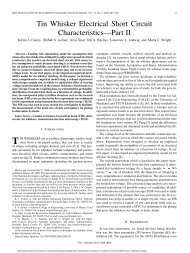
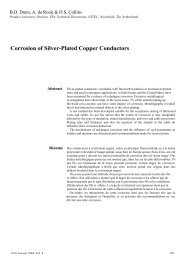
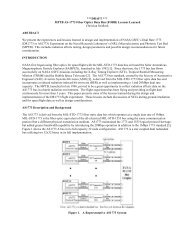

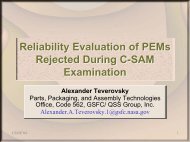
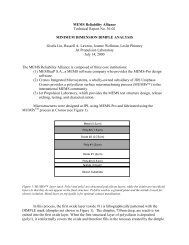
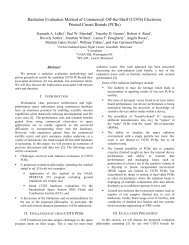
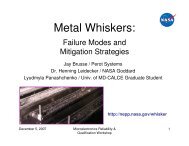
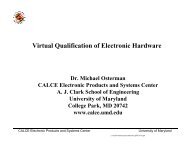
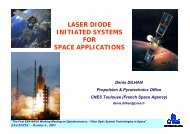
![mil-std-2223 [test methods for insulated electric wire] - NEPP](https://img.yumpu.com/4036001/1/190x249/mil-std-2223-test-methods-for-insulated-electric-wire-nepp.jpg?quality=85)